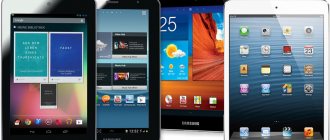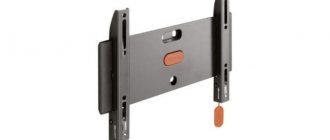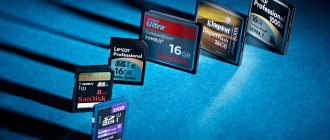Home page » Smartphone display dimensions in inches, pixels, centimeters
Articles
Victor
16:9 or 16:10 is the display aspect ratio of the majority of smartphones. To describe screen characteristics such as diagonal, it is customary to use inches, and when it comes to sensitivity, pixels.
How do you measure the diagonal of a smartphone?
If you haven’t lived your whole life in a village, then the essence of the diagonal should be clear to you. In fact, the diagonal shows the distance measured from one corner of the screen to the opposite. In the technical specifications, this parameter is indicated in inches - this has been the case since the days of “pot-bellied” TVs.
It should be noted that different smartphones with the same screen diagonal may have different heights and widths. The fact is that the size of the device is influenced by two other factors:
- Side frames - if they are narrow, then the width of the gadget will be relatively small. And narrow or completely absent side frames make managing the operating system and applications more convenient.
- Aspect ratio - the width of the device also depends on it. Tablets most often use a display with an aspect ratio of 5:4. On smartphones, the most popular settings are 16:9 and 18:9. In the second case, the device turns out to be narrow and ideal for simultaneously displaying two applications.
If you look at old smartphones, you will notice that they have a small screen (3.5 inches was the most popular diagonal), but huge bezels around it. Now technology has reached the point where the side frames can be quite narrow. And in the future, many smartphones will not have them at all (similar models still exist, but their number is very small). In short, from now on engineers have the opportunity to build fairly large LCD panels into relatively compact gadgets. This makes smartphones more versatile. They become more convenient for watching movies and spending free time playing games.
Tablet screen proportions
An enlarged 8″ tablet or phone screen has a different aspect ratio in inches or cm:
- Panoramic - 16:10.
- The standard is 4:3.
In the bedroom.
When working with email and content, an eight-inch tablet or phone screen with these proportions is more ergonomic to work with. The keyboard has become larger, making it more comfortable for typing.
A widescreen 8″ tablet has a slightly wider monitor than regular monitors on TVs and smartphones. Its width and height are defined as 16:10. It is difficult to hold such a tablet with one hand and browse the web; your thumb cannot reach the buttons. Tablets 8″ and larger are rarely used as phones.
Tablet screen in centimeters
What does the diagonal affect?
Do not miss:
- Which phone with a large screen should you buy in 2021?
- Which TV is best to buy in 2021?
- How to choose a quadcopter. Instructions for beginners - all about...
A lot depends on the diagonal of the smartphone display. First, it affects the way you use the device. Secondly, power consumption and stability of operation depend on the size of the screen. In short, let's figure it out.
Let's start with the user experience. If you buy a phablet (a smartphone with a display diagonal larger than 5.5 inches), you run the risk of encountering certain problems. Such a gadget may not fit into a shirt pocket or the back pocket of jeans. You will also have to regularly use your second hand - experience shows that the user does not have a chance to reach the upper corners with his thumb. But on a device with a large display, movies look great! Just don’t forget to make sure that the screen of the smartphone you purchase has a high resolution! However, we will talk about this separately. The large display also makes it easier to type text when working with documents. That is why phablets from the Samsung Galaxy Note series have always been popular among office workers.
It is difficult to say anything specific about devices with a small or medium display. At least in terms of user experience. Some will say that it is impossible to read books or watch movies on a 4.7-inch LCD panel. But in fact this is completely untrue. To be honest, to watch videos it is better to use a tablet with a 10-inch screen or even a TV. More compact devices will in any case be less convenient for these purposes. By the way, the author of this article as a child calmly read several books on the Siemens CX70 with its tiny TFT display. And on the 2.2-inch screen of the Nokia E65 smartphone, we watched the sixth season of the TV series “Lost.” In short, if the content is interesting, then a small screen will not cause any inconvenience.
We stock up on energy for big and juicy pictures
Well, what can we say about the influence of the LCD display on the performance of the smartphone? Perhaps you have already guessed that a large diagonal consumes significant amounts of energy. At least this applies to IPS panels and screens made using similar technology. They have a separate backlight layer that evenly illuminates the entire display area. And if this area is larger, then the battery charge is consumed more actively. That's why larger smartphones often come with larger batteries. If the screen is made using AMOLED technology, then everything is not so bad - the differences between different diagonals will be less noticeable (but they still do not disappear).
Large resources are spent to display images on a larger screen. That is, if two smartphones with different displays have the same processor, then the larger device will work slower. Although this is not true in the full sense of the word, resolution, not diagonal, has the greatest impact on performance.
Another important point
The last important parameter that allows you to get maximum image quality on the touch surface of the device is OGS technology. Its essence lies in the fact that there is no air gap between the surface of the screen matrix and the upper touch glass. That is, they are one whole. Due to this, viewing angles are significantly increased (they almost reach 180 degrees) and the picture on the mobile phone display is not distorted. This technology is implemented on premium devices and partly on the most advanced gadgets in the mid-price range.
Which screen diagonal is more popular: 4,5,6,7?
Recently, large companies have almost completely stopped producing smartphones with a display diagonal of less than 5 inches. Only Apple continues to produce compact devices. And their owners will tell you that smartphones with relatively small screens are the most convenient to use. Unfortunately, lovers of Android devices have stopped taking the 4.3 to 4.7-inch diagonal seriously. Therefore, manufacturers decided to concentrate their efforts on larger devices.
Numerous surveys show that people like devices with screen sizes ranging from 5.0 to 5.3 inches. If the side frames are narrow or absent altogether, then a 5.5-inch or even 5.7-inch diagonal is quite acceptable. These are the parameters that the vast majority of smartphones currently selling have.
Devices with a screen whose diagonal exceeds 5.7 inches are already so-called phablets. They are close to the performance of tablets, but they are not very convenient to use. Such smartphones are also popularly called “shovels.” Despite the fact that using them for raking sand and snow is also inconvenient, their size is clearly insufficient for this.
Top 10. Alcatel 1 (5033D)
Rating (2021): 3.57
89 reviews from resources taken into account: Yandex.Market, Citylink, Otzovik
The most stable of the cheap ones. There are no complaints about software glitches or unauthorized shutdowns in the reviews.
- Characteristics
Average price: 5150 rub.
- Country: France
- Screen: 5 inches, 960x480, TFT TN
- Chipset: MediaTek MT6739, 4 cores, 1280 MHz
- Battery: 2000 mAh
- Weight: 134 g
If you need a light, small and inexpensive smartphone with stable mobile communications, trouble-free operation of instant messengers and a good flashlight, this model will be the best solution. Reviews say that thanks to the simplified modification software, the phone works without failures even with 1 GB of RAM. The only thing the owners are dissatisfied with is the screen: it has a TN matrix, which means inversion at the slightest deviation of the viewing angle from strictly perpendicular. The sensor recognizes only two simultaneous touches: this is enough for basic tasks, but for some it may be important. The camera is good for capturing the ad in large print.
Advantages and disadvantages
- Light weight and compact dimensions
- No connection problems
- Small viewing angles
- The battery barely lasts until the evening
- Camera without autofocus
What should the display resolution be?
Long gone are the days when we were content with a resolution of 240 x 320 pixels. Now the screen sizes have increased, and therefore the resolution should be higher. Why? Everything is very simple. If we watch TV from afar, then the smartphone is usually a meter from our face or even closer. The resulting low resolution causes us to see individual pixels. You will like this least of all when reading text. And low resolution will not allow you to appreciate any film or video.
If the screen diagonal is 4.7 inches or slightly larger than this parameter, then HD resolution (1280 x 720 pixels) will be enough for you. Such a display will not overload the processor, so you can run many modern games even if you have a weak chipset.
If the display diagonal is at least 5 inches, then Full HD resolution (1920 x 1080 pixels) will be ideal. In this case, individual pixels can only be seen under a magnifying glass. It should also be remembered that many films are now distributed in this resolution. But do not forget that such a screen has high power consumption.
5.5 inches - minimum Full HD
Finally, when reaching 5.5 inches, the traditional Full HD resolution may not seem enough. That's why flagship smartphone screens now have 2K or even 4K resolution! Such devices are ideal for use in conjunction with a virtual reality helmet. Even under huge lenses, individual pixels will only be visible after you stare at what's happening on the screen for a long time. Such smartphones must have a high-resolution camera, otherwise the photos will look lacking in detail. The device must also have a capacious battery, because such a high resolution will consume huge amounts of energy. However, modern processors are increasingly struggling with this factor, which is good news.
It should be remembered that the changed aspect ratio affects the screen resolution. If for 16:9 the usual values are 720 x 1280 and 1080 x 1920 pixels, then in the case of atypical aspect ratios the manufacturer adds 100-200 pixels to the height. In this regard, games will put an increased load on the processor, because it will have to process additional pixels. This is worth remembering when you choose a smartphone with a narrow screen.
Pixels in a smartphone display
Pixels are not used to determine the physical size of a monitor. They display the size of the image located on it. When we talk about resolution, we mean the number of dots located both horizontally and vertically. This indicator, together with the diagonal, measured in inches, is used to calculate pixel density. A high value guarantees a clearer picture.
For a user holding the device no closer than 30 cm from the eyes, it is difficult to concentrate on individual points if the ppi exceeds 300. Back in 20110, such density was available only on Apple devices made using Retina technology. However, in today's realities, even Chinese phablets belonging to the middle class are equipped with FullHD screens (1920 by 1080 pixels).
Five-inch smartphones may well have HD resolution (1280 by 720 pixels). Some manufacturers install displays with a resolution of 2K (2560 by 1440) and 4K (3840 by 2160) on their smartphones. However, the benefits of such innovations can only be seen when familiarizing yourself with VR content.
What else should you pay attention to?
The screen of any portable device has a certain diagonal and resolution. Now you've got it. Now the aspect ratio may also differ, which you already know. Well, what other parameters do LCD displays have?
The first thing that comes to mind is the technology of creation. The cheapest smartphones may have a TFT screen. This will be your worst choice! The display created using this technology has very limited viewing angles. If you tilt the device slightly, the colors will be distorted or even inverted. This will significantly reduce the comfort of watching movies or, especially, games. Also, such LCD panels behave disgustingly on the street.
Rest assured, every photography process will become terribly inconvenient for you. Fortunately, now even budget devices are increasingly equipped with an IPS display. Viewing angles in this case depend on specific production methods. But even the cheapest panels distort the picture when the device is tilted, then only barely. Many buyers do not notice such distortions at all, despite the fact that they are still present! And if the screen is expensive, then you won’t see any problems with the picture at all. At the same time, the colors will be as natural as possible. Such LCD panels are built into the iPhone, as well as smartphones from other major manufacturers.
AMOLED screens
Do not miss:
- Which phone with a large screen should you buy in 2021?
- Which TV is best to buy in 2021?
- How to choose a quadcopter. Instructions for beginners - all about...
AMOLED screens perform best in terms of energy consumption. This is due to the fact that such a display does not have a separate backlit layer. Each of its pixels glows independently. It is easy to guess that a large number of black colors on the screen will lead to lower power consumption. Also, such screens have an expanded color range (although the most expensive IPS matrices are almost as good). Because of this, some people find the picture on the AMOLED display too bright and saturated. However, most often there is no problem with this. For example, on Samsung smartphones you can select a specific color profile, excluding saturation - in this case, in terms of picture quality, the screen will be similar to any IPS panel.
The viewing angles of AMOLED screens are maximum. And if the display belongs to one of the latest generations, then there is a high chance of finding the “Screen always on” option in the smartphone settings. When it is turned on, the device will constantly display the date, time and some other information. Most of the screen will remain black, so this feature has virtually no effect on power consumption.
When choosing a smartphone, you may wonder how bright the backlight is. However, often this parameter is not indicated in the technical specifications. Therefore, it is better to read reviews of the selected device. They will definitely contain photographs of how the device behaves on the street. But safety glass is usually mentioned in the specifications. However, its manufacturer is not always written. Be that as it may, if the glass was created by Corning, then at least focus on the third generation Gorilla Glass. Glass of different generations differs from each other in thickness and strength. The newer the glass, the thinner it is, and it can also withstand a fall from a greater height.
Top 7. INOI 2 Lite 2021 8GB
Rating (2021): 3.86
193 reviews taken into account from resources: IRecommend, Yandex.Market, Ozon, Otzovik
- Characteristics
Average price: 3459 rub.
- Country: Russia (manufactured in China)
- Screen: 5 inches, 854x480, TFT
- Chipset: Spreadtrum SC7731E, 4 cores, 1300 MHz
- Battery: 2500 mAh
- Weight: 143 g
A budget smartphone from a Russian brand with a small 5-inch screen. The model is the latest, so Android 10 works as the operating system. Inoi 2 Lite does not have 4G - be careful when choosing, since many online stores erroneously state LTE support in the specifications. The battery is 25% larger than most 5-inch competitors, resulting in slower battery drain. Enough for a day with moderate load. The performance is very weak - it is barely enough to make calls and work with instant messengers and the browser. If you are looking for a compact model specifically for such purposes, it would be wise to support a domestic brand.
Advantages and disadvantages
- Latest software
- Battery is larger than usual
- Reasonable price
- No 4G
- Large frames at the top and bottom of the screen











